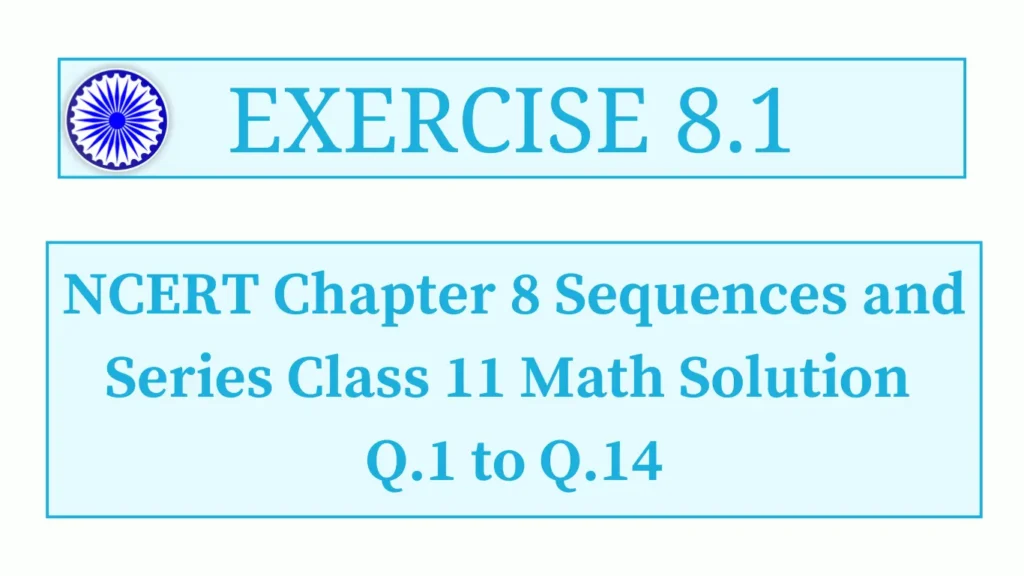
Exercise 8.1 NCERT Class 11 contains 14 questions that are basic and concept-based.
We have written the solutions in such a way that anyone can easily understand the solution steps. Our solutions involve two thought steps. One is knowing the concepts involved, and the other is writing the solution in the required series of steps.
Exercise 8.1 NCERT Class 11 Math Solutions
Write the first five terms of each of the sequences in Exercises 1 to 6 whose nth terms are:
1.
Thought: To find the first five terms of the given sequence, just put the value of n equal to 1, 2, 3, 4 and 5 in the equation.
Sol:
It is given that nth term = n(n+2)
Putting n = 1
1st term = 1×(1+2) = 3
Putting n = 2
2nd term = 2×(2+2) = 8
Putting n = 3
3rd term = 3×(3+2) = 15
Putting n = 4
4th term = 4×(4+2) = 24
Putting n = 5
5th term = 5×(5+2) = 35
Hence, the first five terms of the given sequence nth term = n(n+2) are 3, 8, 15, 24 and 35.
2.
Putting n = 1
1st term = =
Putting n = 2
2nd term = =
Putting n = 3
3rd term = =
Putting n = 4
4th term = =
Putting n = 5
5th term = =
Hence, the first five terms of the given sequence nth term = are , , , , .
3.
Putting n = 1
1st term = 21 = 2
Putting n = 2
2nd term = 22 = 4
Putting n = 3
3rd term = 23 = 8
Putting n = 4
4th term = 24 = 16
Putting n = 5
5th term = 25 = 32
Hence, the first five terms of the given sequence nth term = 2n are 2, 4, 8, 16 and 32.
4.
It is given that nth term =
Putting n = 1
1st term = =
Putting n = 2
2nd term = =
Putting n = 3
3rd term = = =
Putting n = 4
4th term = =
Putting n = 5
5th term = =
Hence, the first five terms of the given sequence nth term = 2n are , , , and .
5.
It is given that nth term = (-1)n-1 5n+1.
Putting n = 1
1st term = (-1)1-1 51+1 = (-1)0 52 = 1×25 = 25
Putting n = 2
2nd term = (-1)2-1 52+1 = (-1)1 53 = -1×125 = -125
Putting n = 3
3rd term = (-1)3-1 53+1 = (-1)2 54 = 1×625 = 625
Putting n = 4
4th term = (-1)4-1 54+1 = (-1)3 55 = -1×3125 = -3125
Putting n = 5
5th term = (-1)5-1 55+1 = (-1)4 56= 1×15625 = 15625
Hence, the first five terms of the given sequence nth term = (-1)n-1 5n+1 are 25, -125, 625, -3125 and 15625.
6.
Sol:
It is given that nth term
=
Putting n = 1
1st term = = =
2nd term = = =
3rd term = = =
4rd term = = =
5rd term = = =
Hence, the first five terms of the given sequence are and
Find the indicated terms in each of the sequences in Exercises 7 to 10 whose nth terms are given:
7.
Thought: We need to put the value of n = 17 and n = 24 to find the required terms.
Sol: The given sequence is
term =
term =
8.
term ==
9. =
Sol: The term of the given sequence is .
729
10.
==
Write the first five terms of each of the sequences in Exercises 11 to 13 and obtain the corresponding series:
11. a 1 = 3 , a n = 3 a n – 1 + 2
Thought: First term is given, we can find the next terms using the second expression by putting the first term into it
Now, it is given that
So, putting the value of n = 2, we get,
The second term =
Similarly,
the third term =
The fourth term =
The fifth term =
Hence, the first five terms of the given sequence are 3, 11, 35, 107 and 323.
12. a 1 = − 1 , a n = a n – 1 n , n ≥ 2
Now, it is given that
So, we can get the value of other terms by just putting the value of n.
The second term =
The third term=
The fourth term =
The fifth term =
Hence, the first five terms are
13. a 1 = a 2 = 2 , a n = a n - 1 - 1 , n > 2
Sol: Clearly, the first term = 2,
and the second term = 2,
Now, it is given that
The third term =
The fourth term =
The fifth term =
Hence the first five terms are 2, 2, 1, 0, and -1.
14. The Fibonacci sequence is defined by
a 1 = a 2 = 1 , a n d
a n = a n - 1 + a n - 2 , n > 2
Find a n + 1 a n
Sol: We need to find the first six terms of the sequence.
Given that
We need to find the next three terms to find the ratio being asked:
Now,
For n = 1, we have
For n = 2, we get
For n = 3, we get
For n = 4, we get
For n = 5, we get
Hence, the required values of
